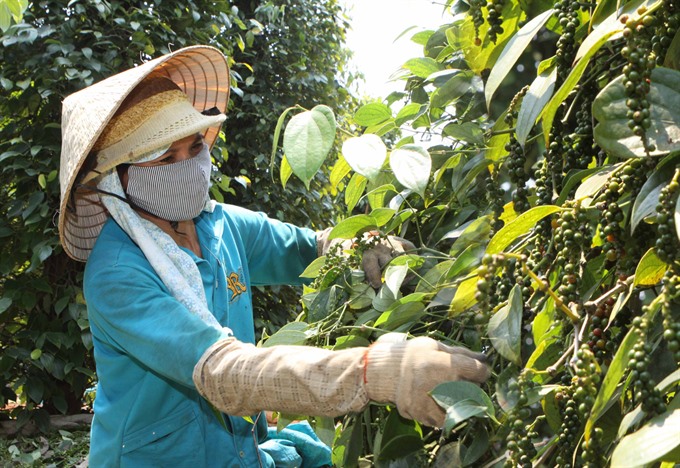A pepper glut in the Central Highlands as more and more farmers switched to the crop. This is the result of the earlier high profits from the spice. Too many pepper fields can leads farmers to the bankrupt situation.

A farmer harvests pepper in the Central Highlands province of Đắk Lắk.
The massive expansion of the area under pepper and output has made regional master plans for the spice redundant and local authorities helpless and threatened the well-being of many local farmers.
In the region which has been known as the largest pepper producer in the country, Đắk Lắk, Đắc Nông and Gia Lai provinces, the main pepper-growing areas, have 68,600 hectares under the crop now. The master plan had envisaged them having 18,000ha in 2020.
With the local weather and soil being ideal for pepper, the average yield here is 3.15 tonnes per hectare, and the spice has always fetched high incomes for locals.
Pepper market crash
But this year’s pepper market has seen prices crashing by half to just VNĐ100,000 (US$4.5) per kilogram. As a result, tens of thousands of farming households are in debt, with many going bankrupt.
Cư Kuin, Chư Sê and Chư Pưh districts in Gia Lai Province have for long been famous for their pepper. Due to the high profits in recent years, many farmers here have switched from other plants to pepper.
Phạm Hồng Nhật of Hamlet 3, Nâm NDjang Commune, Cư Kuin District, became wealthy over the years thanks to pepper but faces difficulties this year.
“My family harvested 40 tonnes of pepper, and I did not want to sell it because the price was so low, but I had to sell 20 tonnes for day-to-day expenses, I’m really worried about the pepper market.”
Nguyễn Hữu Tâm, deputy chairman of the Chư Sê District Pepper Association, shared to Nhân Dân (People) newspaper: “Many farmers borrowed money at high-interest rates. They will surely be in debt because of low pepper prices.”
Plant disease
The glut came about because farmers switched en masse to pepper without support plans and ignored all authorities’ warnings.
It has rendered local agricultural main plans irrelevant and unleashed plant diseases due to massive fertilizer use and failure to nourish the land.
According to a recent survey by the Việt Nam Pepper Association, Gia Lai has over 6,100ha of disease-hit lands, while the yields in Chư Sê and Chư Pưh districts have declined by 25-30 percent.
The association said local authorities could not control the area under pepper or the quality of seeds used for planting. Farmers sell Low-quality pepper everywhere, resulting in increasingly lower yields.
But there is no in-depth research into the diseases or incubation of pepper projects.
The action of government:
According to the Steering Committee of the Central Highlands, there were over 1,700 violations of the Forest Law in the first six months of this year, including 323 cases involving the destruction of 122ha of forest to grow pepper plants.
To improve the situation of pepper market, the Central Highlands Agricultural, Forestry Science and Technology Institute has organized agricultural encouragement forums, undertaken technology transfer, provided technical training and set up pilot pepper farming models.
It hopes these activities will apprise local farmers and authorities about the situation and teach them how to grow pepper sustainably.
“It is necessary to build a ‘Vietnamese pepper’ national brand name, and more investment is needed to build pepper into a strong industry,” Nguyễn Trí Ngọc, head of the Ministry of Agriculture and Rural Development’s Crops Production Department, told a recent seminar on pepper development. —
Source: https://vietnamnews.vn/economy/395163/mass-switch-to-pepper-causes-market-crash.html











